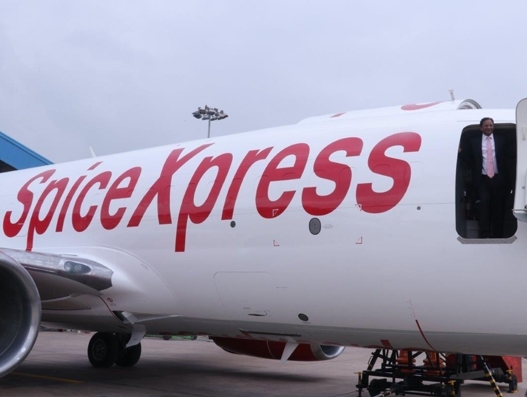
FROM MAGAZINE: New national air cargo policy aims to make India a transit cargo hub of choice
The new National Air Cargo Policy released recently by the Indian government defines the way forward for making India a transit cargo hub of choice to-and-from other parts of the world and aims to ensure efficient flow of goods across India, facilitating all indigenous export and import of goods. Nahida Jafferi India’s Union Minister of […]

The new National Air Cargo Policy released recently by the Indian government defines the way forward for making India a transit cargo hub of choice to-and-from other parts of the world and aims to ensure efficient flow of goods across India, facilitating all indigenous export and import of goods.
Nahida Jafferi
India’s Union Minister of Commerce and Civil Aviation, Suresh Prabhu, unveiled the National Air Cargo Policy 2019 at the recent Global Aviation Summit held in Mumbai. The new cargo policy aims to position India among the top five global air freight markets, in addition to building air transhipment hubs at all major Indian airports, by 2025. Also high on its agenda is to build India’s rank in the top five markets with e-AWB penetration.
The policy mandates integrating post offices to the air cargo value chain at the village post office level, and development of regional and state cargo hubs, which will act as gateways for the region and states, connected by domestic trade corridors to production hubs.
“The domestic and international air cargo network will dovetail with the postal network through a common user platform to provide first and last mile connectivity for air cargo. Any air logistics company will be able to connect with the postal network based on a pre-defined connectivity interface. This will connect villages to both the urban domestic market and international markets providing free flow of goods through air cargo,” the policy document states.
Furthermore, the aim is also to leverage India's geographical location as a transit hub between Europe and Southeast Asia and a gateway to the South Asian region. The government also aims to do away with paper correspondence and implement digital transactions wherever possible, which it hopes will reduce the time cargo is held up at airports, while also eliminating revenue leakage in the logistics chain. Use of new technology like internet of things, artificial intelligence and block chain will also be encouraged.
“This is a great value addition to the existing soft and hard infrastructure of the postal department. It will also bring down costs which will benefit the small traders as well as families who need to send small parcels across,” commented Samir J Shah, Owner, JBS Group of Companies.
He further added, “The systematic and inclusive approach adopted with a series of large and small consultations and exchanges of thoughts was indeed a first government policy.”
Bharat Thakkar, co-founder, Zeus Air Services, stated, “We as freight forwarders need to change our mindset. The ones with strong last mile connectivity in the supply chain will be winners in the next decade. Let us see how our industry will adopt as even courier companies use SpeedPost.”
The air cargo policy comes on the heels of the cabinet approval for the agriculture export policy that aims to increase India's agri exports to $100 billion as opposed to current $30 billion. Air cargo and logistics will play a big role in driving this growth. “Aviation is an integral part of logistics. The idea is to create logistics hubs in India, and also link ourselves to the logistics chains of the world,” Prabhu added.
The air cargo handled at Indian airports grew by more than 20 times from 0.08 million tonnes in 1972-73 to 2.5 million tonnes in 2014-15. Between 2013-14 and 2017-18, it has grown at a compounded rate of 10 percent. The domestic express industry is estimated to be worth Rs 170 billion. International express is estimated to contribute Rs 50 billion to the Indian express industry.
The policy document states that there will be an integration of domestic and international air cargo network with the postal network at the village post office level through a common user platform to provide first and last mile connectivity for air cargo.
In addition, agreements between national and international carriers/freighters and other airline operators to provide access to key global cargo hubs is part of the new policy.
“There is a need to devise policies to explore the potential in new markets like Africa and South East Asia, by creating long-term infrastructure in order to sustain cargo growth in at least the next 10-15 years,” the policy addressed.
The document also exclusively referred to the regulatory policies supportive of air cargo growth like the National Integrated Logistic Policy (NILP), which focus on increasing the capacity of storage and warehousing, and other value-added services with setting up of multi-modal logistics parks and integrating various transportation modes.
To facilitate the ease of doing business, the policy stressed upon each process step involved in trade from pre-arrival processing/ shipper's gate to clearance and out of charge/ consignee's door to be carried out through a digital platform. This will increase transparency and decreasing shipment costs and delays. “We are looking towards all processes now becoming totally system driven without human intervention. If we are able to achieve paperless age, it will enable ease of doing business and contribute to the digital India objective of the current government at the centre. Some regulatory processes need to be added to achieve that,” commented Thakkar.
In addition, use of new technology like the Internet of Things (IoT), Artificial Intelligence (AI) and Block Chain will be encouraged, while ensuring the highest levels of data security and privacy protection.
For speedy movement of high-value air cargo, the government plans development of Trade corridors with major international trading partners to facilitate customs clearance. Automated data exchanges between Indian airports and major international airports by developing digital air cargo corridors, is the future strategy.
Most importantly, to make the policy functional, an Inter-Ministerial body needs to be set up by the Air Cargo Logistics Promotion Board (ACLPB), for planning, co-ordination, implementation and monitoring. Furthermore, the policy mentioned that ACLPB should strengthen cooperation and consideration between international and domestic carriers to effectively utilise their hubs. Besides this, the establishment of international hub-to-hub cargo trade lanes is about to gather steam.
Also within the policy ambit is the integration of all airports and air cargo stakeholders within a single/unified National Air Cargo Community System (NACCS) architecture. National Logistics Portal is being developed to ensure ease of trading in the international and domestic markets, as India eyes lowering logistics cost from 14 percent of GDP to less than 10 percent by 2022. In developed countries, logistics cost is in the range of 7-8 percent of GDP. The Airports Economic Regulatory Authority of India (AERA) approval mechanism and mandate shall institute an efficient and transparent air cargo tariff process, according to the policy.
The policy also states that establishing Special Economic Zones (SEZ) at or adjacent to major international airports for promoting India as a global transhipment hub. “Current land requirement and other norms for the setting up of SEZ will be reviewed in a time-bound manner to promote setting up of SEZ keeping in view the limited land availability and higher value to land ratio,” it said.

